Activity Based Budgeting Implementation: BHP Billiton Case Analysis
VerifiedAdded on 2023/06/04
|12
|3541
|215
Report
AI Summary
This report assesses the suitability of activity based budgeting (ABB) for BHP Billiton, a major Anglo-Australian mining company. It begins by describing BHP Billiton's operations and the need for effective budgeting. The report then defines ABB, highlighting its features such as improved resource allocation, transparency, and operational efficiency through cost driver identification and elimination of non-value-added activities. A detailed comparison between traditional budgeting and ABB is provided, emphasizing ABB's focus on activity analysis, cost driver utilization, and alignment with business objectives. The report concludes by discussing the potential benefits of ABB for BHP Billiton, including reduced operational expenses and maximized profitability, given its complex business model and diverse mining product portfolio. This analysis aims to inform BHP Billiton's decision-making regarding the adoption of ABB to enhance its budgeting processes and overall operational performance. Desklib provides access to similar solved assignments and study resources for students.
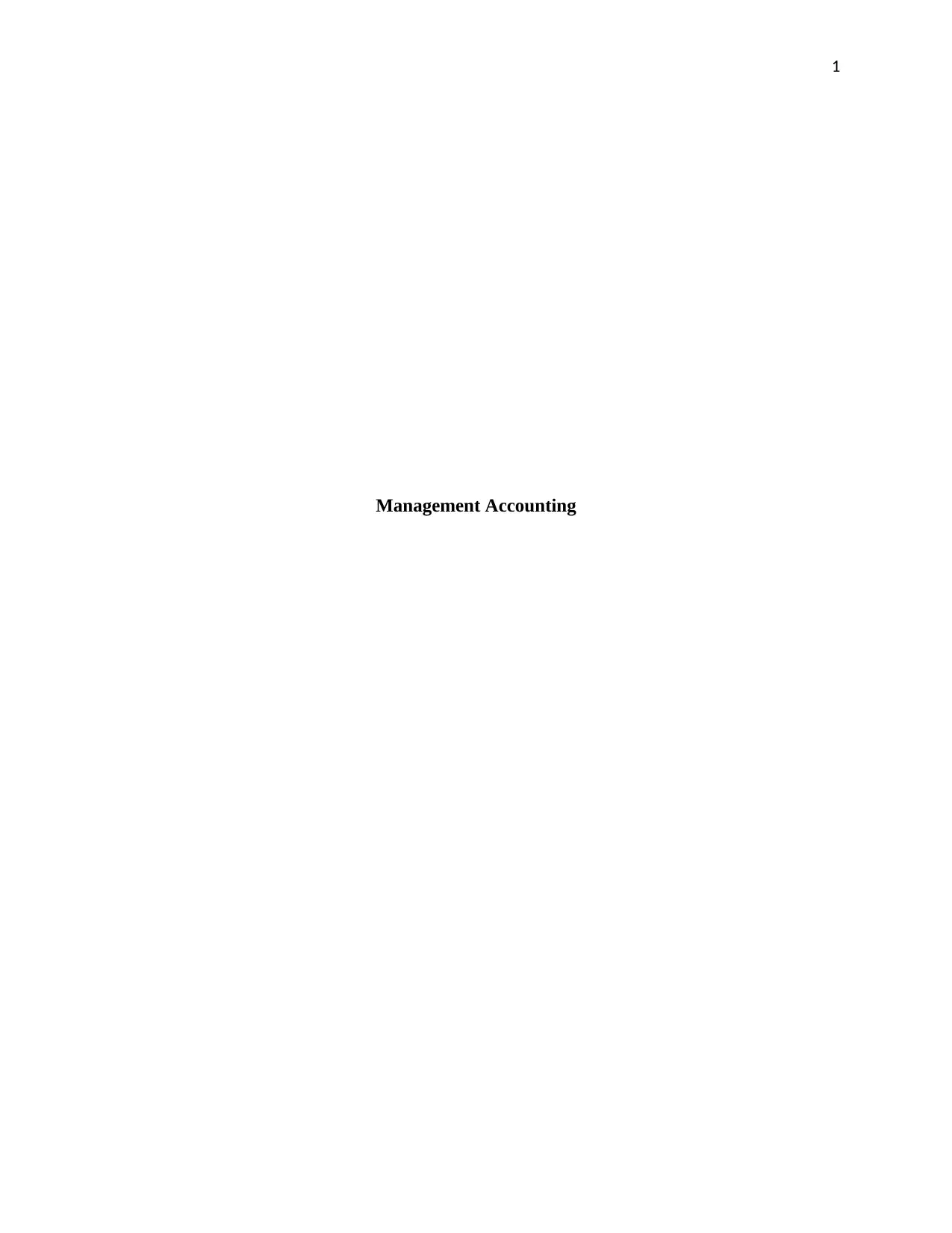
1
Management Accounting
Management Accounting
Paraphrase This Document
Need a fresh take? Get an instant paraphrase of this document with our AI Paraphraser
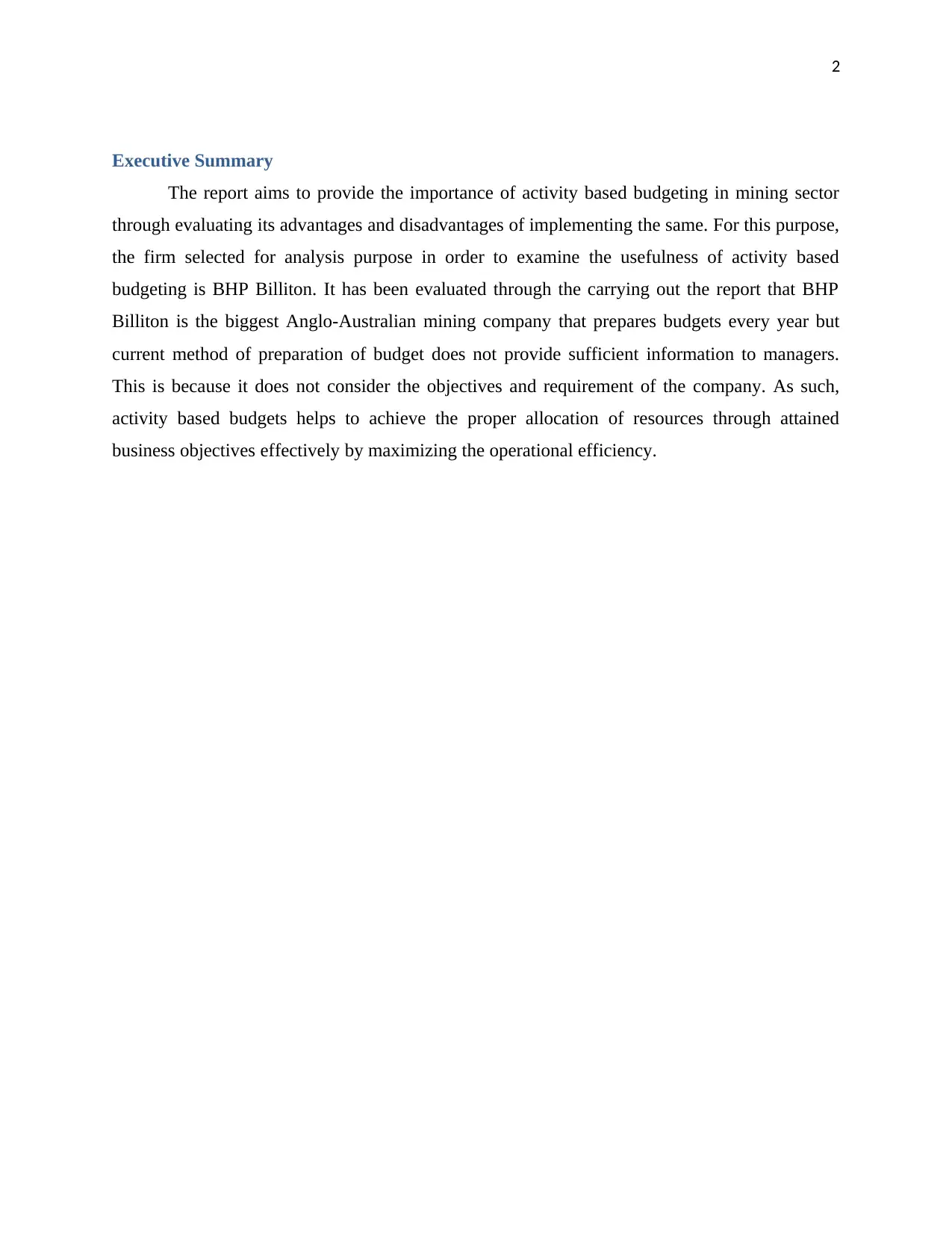
2
Executive Summary
The report aims to provide the importance of activity based budgeting in mining sector
through evaluating its advantages and disadvantages of implementing the same. For this purpose,
the firm selected for analysis purpose in order to examine the usefulness of activity based
budgeting is BHP Billiton. It has been evaluated through the carrying out the report that BHP
Billiton is the biggest Anglo-Australian mining company that prepares budgets every year but
current method of preparation of budget does not provide sufficient information to managers.
This is because it does not consider the objectives and requirement of the company. As such,
activity based budgets helps to achieve the proper allocation of resources through attained
business objectives effectively by maximizing the operational efficiency.
Executive Summary
The report aims to provide the importance of activity based budgeting in mining sector
through evaluating its advantages and disadvantages of implementing the same. For this purpose,
the firm selected for analysis purpose in order to examine the usefulness of activity based
budgeting is BHP Billiton. It has been evaluated through the carrying out the report that BHP
Billiton is the biggest Anglo-Australian mining company that prepares budgets every year but
current method of preparation of budget does not provide sufficient information to managers.
This is because it does not consider the objectives and requirement of the company. As such,
activity based budgets helps to achieve the proper allocation of resources through attained
business objectives effectively by maximizing the operational efficiency.
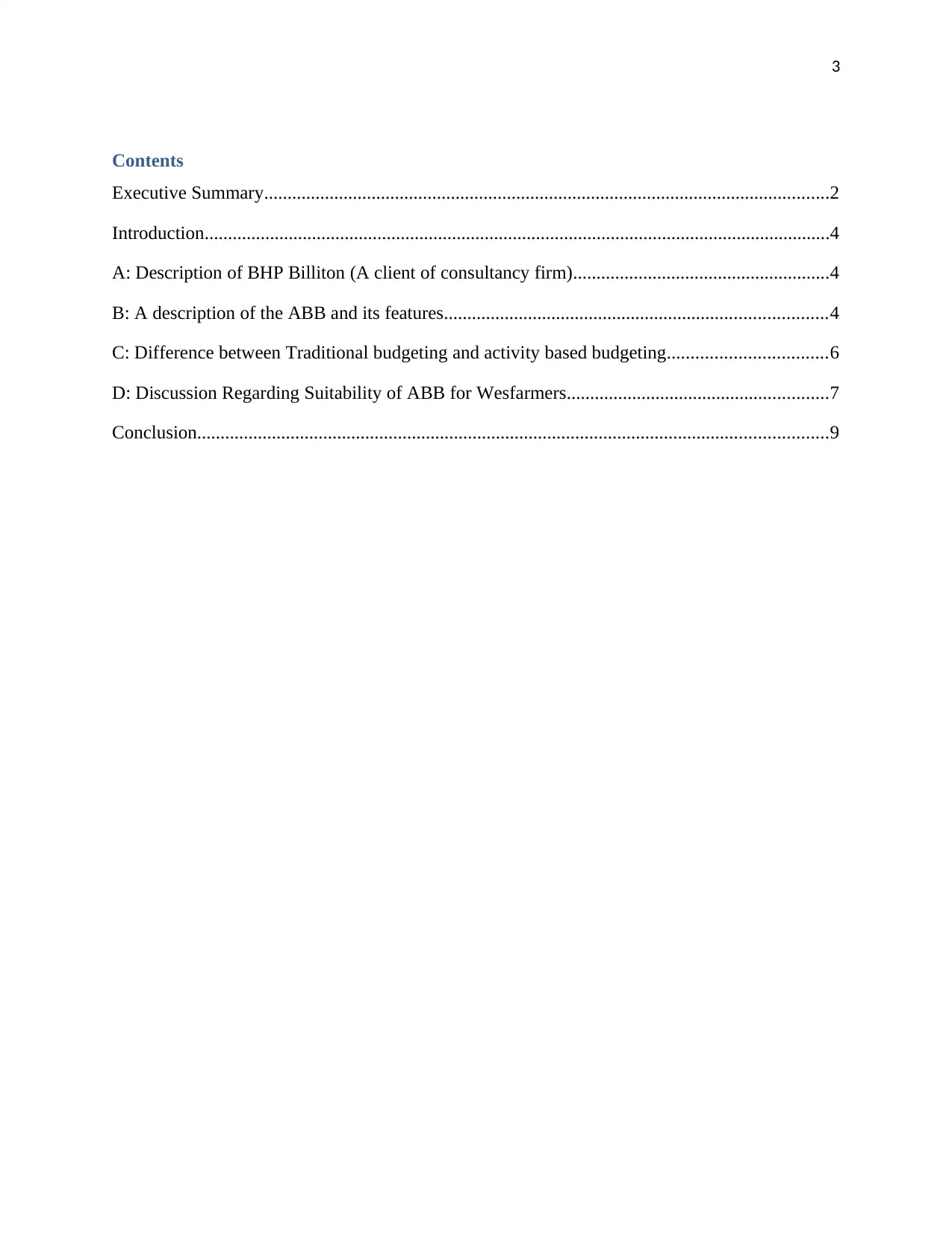
3
Contents
Executive Summary.........................................................................................................................2
Introduction......................................................................................................................................4
A: Description of BHP Billiton (A client of consultancy firm).......................................................4
B: A description of the ABB and its features..................................................................................4
C: Difference between Traditional budgeting and activity based budgeting..................................6
D: Discussion Regarding Suitability of ABB for Wesfarmers........................................................7
Conclusion.......................................................................................................................................9
Contents
Executive Summary.........................................................................................................................2
Introduction......................................................................................................................................4
A: Description of BHP Billiton (A client of consultancy firm).......................................................4
B: A description of the ABB and its features..................................................................................4
C: Difference between Traditional budgeting and activity based budgeting..................................6
D: Discussion Regarding Suitability of ABB for Wesfarmers........................................................7
Conclusion.......................................................................................................................................9
⊘ This is a preview!⊘
Do you want full access?
Subscribe today to unlock all pages.

Trusted by 1+ million students worldwide
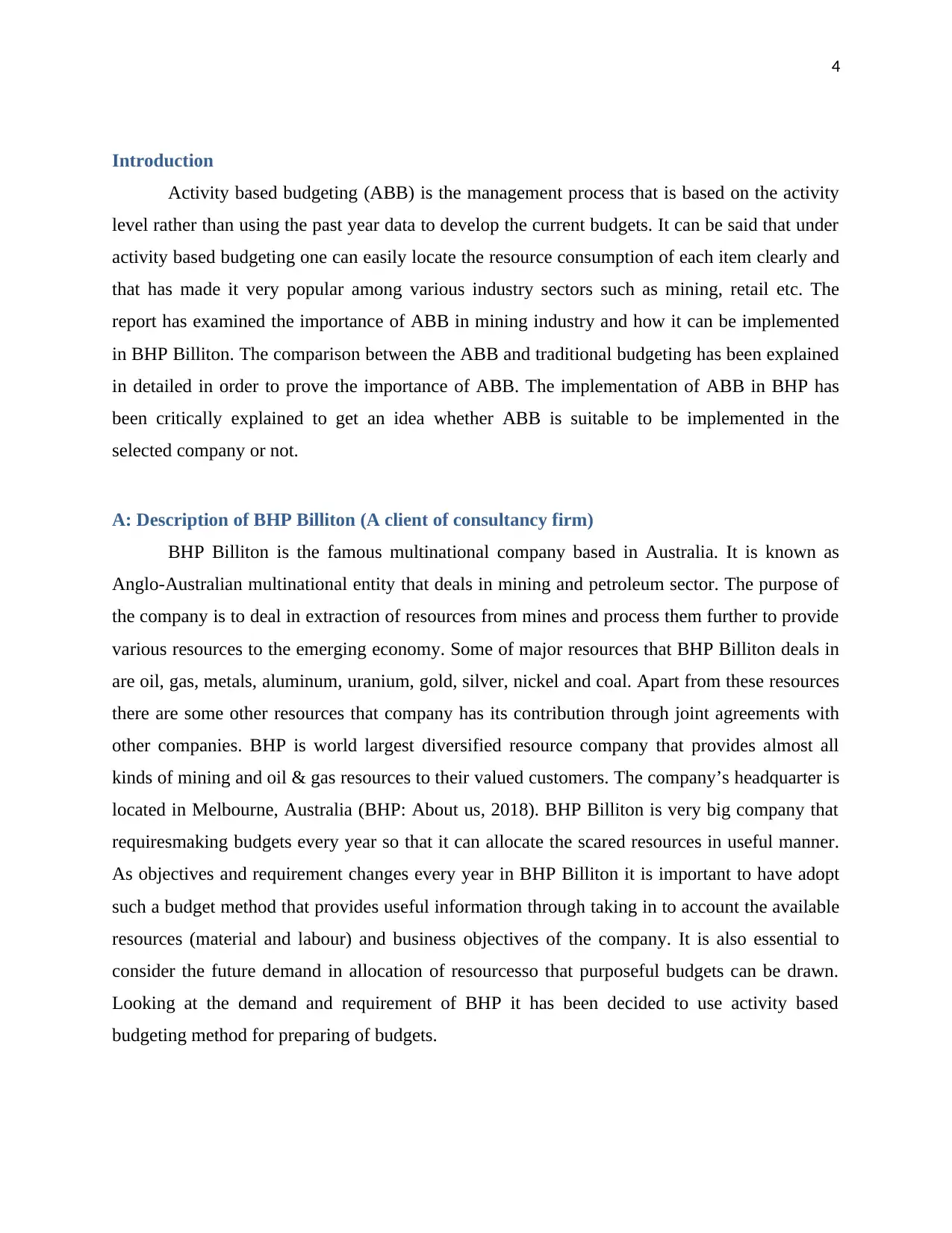
4
Introduction
Activity based budgeting (ABB) is the management process that is based on the activity
level rather than using the past year data to develop the current budgets. It can be said that under
activity based budgeting one can easily locate the resource consumption of each item clearly and
that has made it very popular among various industry sectors such as mining, retail etc. The
report has examined the importance of ABB in mining industry and how it can be implemented
in BHP Billiton. The comparison between the ABB and traditional budgeting has been explained
in detailed in order to prove the importance of ABB. The implementation of ABB in BHP has
been critically explained to get an idea whether ABB is suitable to be implemented in the
selected company or not.
A: Description of BHP Billiton (A client of consultancy firm)
BHP Billiton is the famous multinational company based in Australia. It is known as
Anglo-Australian multinational entity that deals in mining and petroleum sector. The purpose of
the company is to deal in extraction of resources from mines and process them further to provide
various resources to the emerging economy. Some of major resources that BHP Billiton deals in
are oil, gas, metals, aluminum, uranium, gold, silver, nickel and coal. Apart from these resources
there are some other resources that company has its contribution through joint agreements with
other companies. BHP is world largest diversified resource company that provides almost all
kinds of mining and oil & gas resources to their valued customers. The company’s headquarter is
located in Melbourne, Australia (BHP: About us, 2018). BHP Billiton is very big company that
requiresmaking budgets every year so that it can allocate the scared resources in useful manner.
As objectives and requirement changes every year in BHP Billiton it is important to have adopt
such a budget method that provides useful information through taking in to account the available
resources (material and labour) and business objectives of the company. It is also essential to
consider the future demand in allocation of resourcesso that purposeful budgets can be drawn.
Looking at the demand and requirement of BHP it has been decided to use activity based
budgeting method for preparing of budgets.
Introduction
Activity based budgeting (ABB) is the management process that is based on the activity
level rather than using the past year data to develop the current budgets. It can be said that under
activity based budgeting one can easily locate the resource consumption of each item clearly and
that has made it very popular among various industry sectors such as mining, retail etc. The
report has examined the importance of ABB in mining industry and how it can be implemented
in BHP Billiton. The comparison between the ABB and traditional budgeting has been explained
in detailed in order to prove the importance of ABB. The implementation of ABB in BHP has
been critically explained to get an idea whether ABB is suitable to be implemented in the
selected company or not.
A: Description of BHP Billiton (A client of consultancy firm)
BHP Billiton is the famous multinational company based in Australia. It is known as
Anglo-Australian multinational entity that deals in mining and petroleum sector. The purpose of
the company is to deal in extraction of resources from mines and process them further to provide
various resources to the emerging economy. Some of major resources that BHP Billiton deals in
are oil, gas, metals, aluminum, uranium, gold, silver, nickel and coal. Apart from these resources
there are some other resources that company has its contribution through joint agreements with
other companies. BHP is world largest diversified resource company that provides almost all
kinds of mining and oil & gas resources to their valued customers. The company’s headquarter is
located in Melbourne, Australia (BHP: About us, 2018). BHP Billiton is very big company that
requiresmaking budgets every year so that it can allocate the scared resources in useful manner.
As objectives and requirement changes every year in BHP Billiton it is important to have adopt
such a budget method that provides useful information through taking in to account the available
resources (material and labour) and business objectives of the company. It is also essential to
consider the future demand in allocation of resourcesso that purposeful budgets can be drawn.
Looking at the demand and requirement of BHP it has been decided to use activity based
budgeting method for preparing of budgets.
Paraphrase This Document
Need a fresh take? Get an instant paraphrase of this document with our AI Paraphraser
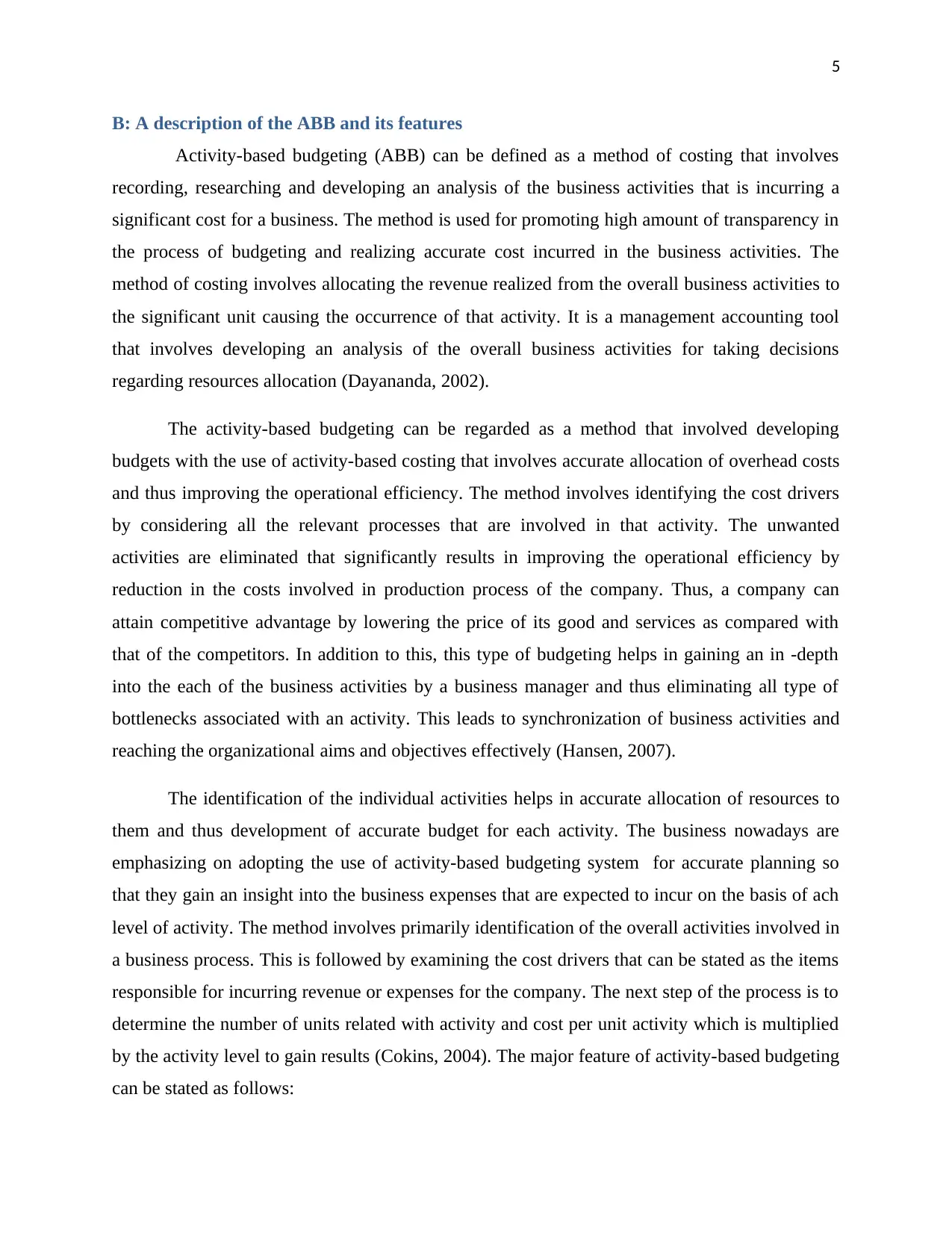
5
B: A description of the ABB and its features
Activity-based budgeting (ABB) can be defined as a method of costing that involves
recording, researching and developing an analysis of the business activities that is incurring a
significant cost for a business. The method is used for promoting high amount of transparency in
the process of budgeting and realizing accurate cost incurred in the business activities. The
method of costing involves allocating the revenue realized from the overall business activities to
the significant unit causing the occurrence of that activity. It is a management accounting tool
that involves developing an analysis of the overall business activities for taking decisions
regarding resources allocation (Dayananda, 2002).
The activity-based budgeting can be regarded as a method that involved developing
budgets with the use of activity-based costing that involves accurate allocation of overhead costs
and thus improving the operational efficiency. The method involves identifying the cost drivers
by considering all the relevant processes that are involved in that activity. The unwanted
activities are eliminated that significantly results in improving the operational efficiency by
reduction in the costs involved in production process of the company. Thus, a company can
attain competitive advantage by lowering the price of its good and services as compared with
that of the competitors. In addition to this, this type of budgeting helps in gaining an in -depth
into the each of the business activities by a business manager and thus eliminating all type of
bottlenecks associated with an activity. This leads to synchronization of business activities and
reaching the organizational aims and objectives effectively (Hansen, 2007).
The identification of the individual activities helps in accurate allocation of resources to
them and thus development of accurate budget for each activity. The business nowadays are
emphasizing on adopting the use of activity-based budgeting system for accurate planning so
that they gain an insight into the business expenses that are expected to incur on the basis of ach
level of activity. The method involves primarily identification of the overall activities involved in
a business process. This is followed by examining the cost drivers that can be stated as the items
responsible for incurring revenue or expenses for the company. The next step of the process is to
determine the number of units related with activity and cost per unit activity which is multiplied
by the activity level to gain results (Cokins, 2004). The major feature of activity-based budgeting
can be stated as follows:
B: A description of the ABB and its features
Activity-based budgeting (ABB) can be defined as a method of costing that involves
recording, researching and developing an analysis of the business activities that is incurring a
significant cost for a business. The method is used for promoting high amount of transparency in
the process of budgeting and realizing accurate cost incurred in the business activities. The
method of costing involves allocating the revenue realized from the overall business activities to
the significant unit causing the occurrence of that activity. It is a management accounting tool
that involves developing an analysis of the overall business activities for taking decisions
regarding resources allocation (Dayananda, 2002).
The activity-based budgeting can be regarded as a method that involved developing
budgets with the use of activity-based costing that involves accurate allocation of overhead costs
and thus improving the operational efficiency. The method involves identifying the cost drivers
by considering all the relevant processes that are involved in that activity. The unwanted
activities are eliminated that significantly results in improving the operational efficiency by
reduction in the costs involved in production process of the company. Thus, a company can
attain competitive advantage by lowering the price of its good and services as compared with
that of the competitors. In addition to this, this type of budgeting helps in gaining an in -depth
into the each of the business activities by a business manager and thus eliminating all type of
bottlenecks associated with an activity. This leads to synchronization of business activities and
reaching the organizational aims and objectives effectively (Hansen, 2007).
The identification of the individual activities helps in accurate allocation of resources to
them and thus development of accurate budget for each activity. The business nowadays are
emphasizing on adopting the use of activity-based budgeting system for accurate planning so
that they gain an insight into the business expenses that are expected to incur on the basis of ach
level of activity. The method involves primarily identification of the overall activities involved in
a business process. This is followed by examining the cost drivers that can be stated as the items
responsible for incurring revenue or expenses for the company. The next step of the process is to
determine the number of units related with activity and cost per unit activity which is multiplied
by the activity level to gain results (Cokins, 2004). The major feature of activity-based budgeting
can be stated as follows:
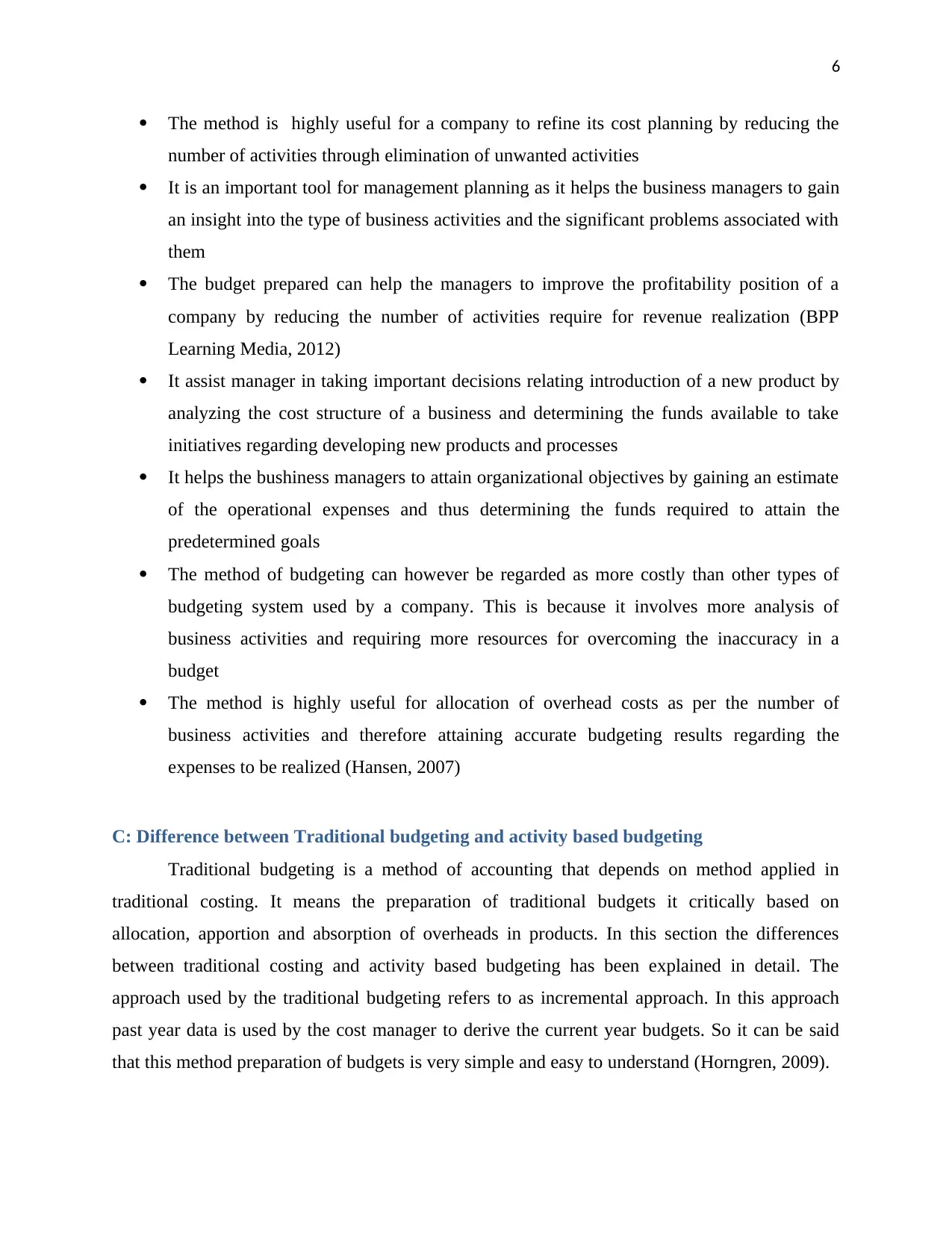
6
The method is highly useful for a company to refine its cost planning by reducing the
number of activities through elimination of unwanted activities
It is an important tool for management planning as it helps the business managers to gain
an insight into the type of business activities and the significant problems associated with
them
The budget prepared can help the managers to improve the profitability position of a
company by reducing the number of activities require for revenue realization (BPP
Learning Media, 2012)
It assist manager in taking important decisions relating introduction of a new product by
analyzing the cost structure of a business and determining the funds available to take
initiatives regarding developing new products and processes
It helps the bushiness managers to attain organizational objectives by gaining an estimate
of the operational expenses and thus determining the funds required to attain the
predetermined goals
The method of budgeting can however be regarded as more costly than other types of
budgeting system used by a company. This is because it involves more analysis of
business activities and requiring more resources for overcoming the inaccuracy in a
budget
The method is highly useful for allocation of overhead costs as per the number of
business activities and therefore attaining accurate budgeting results regarding the
expenses to be realized (Hansen, 2007)
C: Difference between Traditional budgeting and activity based budgeting
Traditional budgeting is a method of accounting that depends on method applied in
traditional costing. It means the preparation of traditional budgets it critically based on
allocation, apportion and absorption of overheads in products. In this section the differences
between traditional costing and activity based budgeting has been explained in detail. The
approach used by the traditional budgeting refers to as incremental approach. In this approach
past year data is used by the cost manager to derive the current year budgets. So it can be said
that this method preparation of budgets is very simple and easy to understand (Horngren, 2009).
The method is highly useful for a company to refine its cost planning by reducing the
number of activities through elimination of unwanted activities
It is an important tool for management planning as it helps the business managers to gain
an insight into the type of business activities and the significant problems associated with
them
The budget prepared can help the managers to improve the profitability position of a
company by reducing the number of activities require for revenue realization (BPP
Learning Media, 2012)
It assist manager in taking important decisions relating introduction of a new product by
analyzing the cost structure of a business and determining the funds available to take
initiatives regarding developing new products and processes
It helps the bushiness managers to attain organizational objectives by gaining an estimate
of the operational expenses and thus determining the funds required to attain the
predetermined goals
The method of budgeting can however be regarded as more costly than other types of
budgeting system used by a company. This is because it involves more analysis of
business activities and requiring more resources for overcoming the inaccuracy in a
budget
The method is highly useful for allocation of overhead costs as per the number of
business activities and therefore attaining accurate budgeting results regarding the
expenses to be realized (Hansen, 2007)
C: Difference between Traditional budgeting and activity based budgeting
Traditional budgeting is a method of accounting that depends on method applied in
traditional costing. It means the preparation of traditional budgets it critically based on
allocation, apportion and absorption of overheads in products. In this section the differences
between traditional costing and activity based budgeting has been explained in detail. The
approach used by the traditional budgeting refers to as incremental approach. In this approach
past year data is used by the cost manager to derive the current year budgets. So it can be said
that this method preparation of budgets is very simple and easy to understand (Horngren, 2009).
⊘ This is a preview!⊘
Do you want full access?
Subscribe today to unlock all pages.

Trusted by 1+ million students worldwide
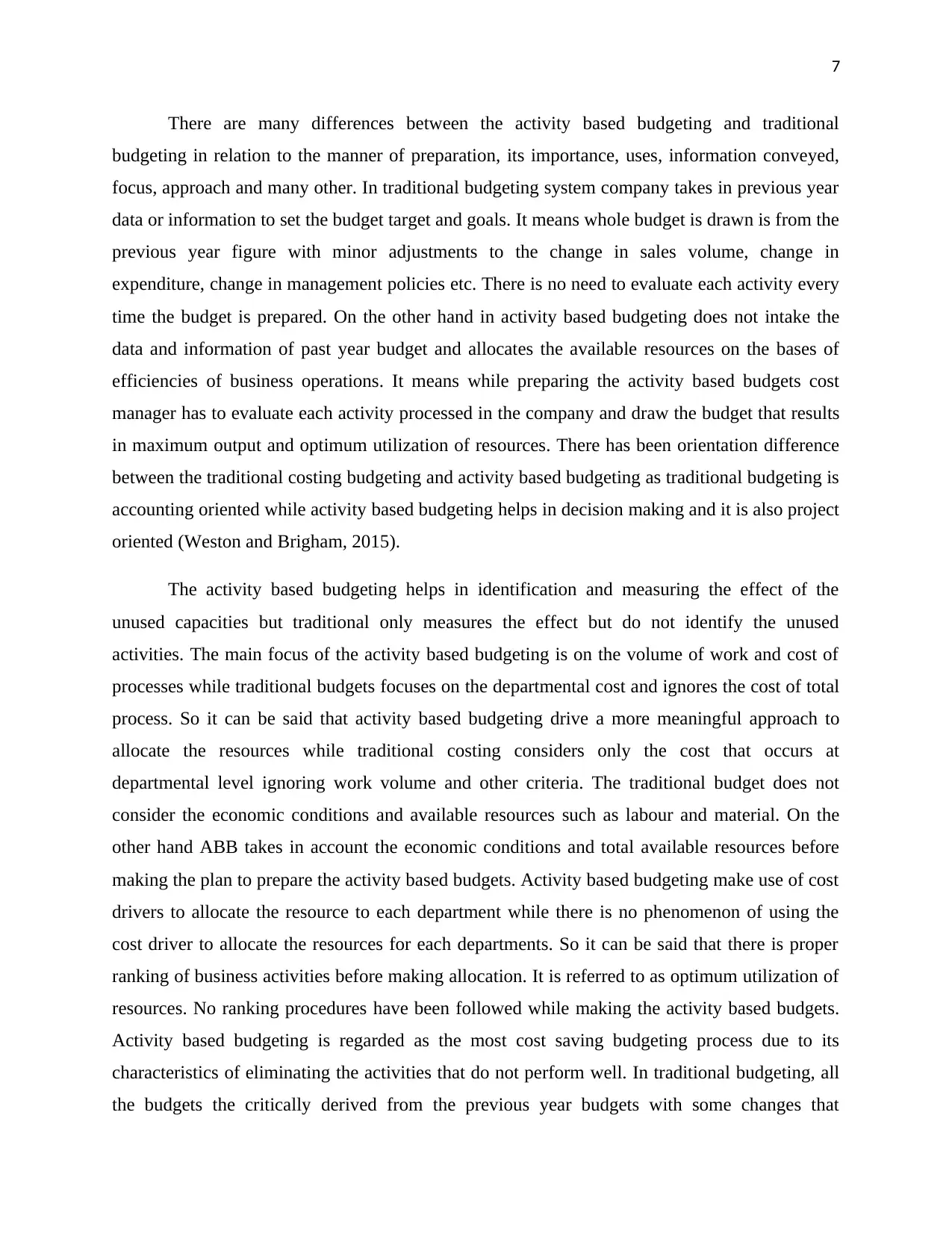
7
There are many differences between the activity based budgeting and traditional
budgeting in relation to the manner of preparation, its importance, uses, information conveyed,
focus, approach and many other. In traditional budgeting system company takes in previous year
data or information to set the budget target and goals. It means whole budget is drawn is from the
previous year figure with minor adjustments to the change in sales volume, change in
expenditure, change in management policies etc. There is no need to evaluate each activity every
time the budget is prepared. On the other hand in activity based budgeting does not intake the
data and information of past year budget and allocates the available resources on the bases of
efficiencies of business operations. It means while preparing the activity based budgets cost
manager has to evaluate each activity processed in the company and draw the budget that results
in maximum output and optimum utilization of resources. There has been orientation difference
between the traditional costing budgeting and activity based budgeting as traditional budgeting is
accounting oriented while activity based budgeting helps in decision making and it is also project
oriented (Weston and Brigham, 2015).
The activity based budgeting helps in identification and measuring the effect of the
unused capacities but traditional only measures the effect but do not identify the unused
activities. The main focus of the activity based budgeting is on the volume of work and cost of
processes while traditional budgets focuses on the departmental cost and ignores the cost of total
process. So it can be said that activity based budgeting drive a more meaningful approach to
allocate the resources while traditional costing considers only the cost that occurs at
departmental level ignoring work volume and other criteria. The traditional budget does not
consider the economic conditions and available resources such as labour and material. On the
other hand ABB takes in account the economic conditions and total available resources before
making the plan to prepare the activity based budgets. Activity based budgeting make use of cost
drivers to allocate the resource to each department while there is no phenomenon of using the
cost driver to allocate the resources for each departments. So it can be said that there is proper
ranking of business activities before making allocation. It is referred to as optimum utilization of
resources. No ranking procedures have been followed while making the activity based budgets.
Activity based budgeting is regarded as the most cost saving budgeting process due to its
characteristics of eliminating the activities that do not perform well. In traditional budgeting, all
the budgets the critically derived from the previous year budgets with some changes that
There are many differences between the activity based budgeting and traditional
budgeting in relation to the manner of preparation, its importance, uses, information conveyed,
focus, approach and many other. In traditional budgeting system company takes in previous year
data or information to set the budget target and goals. It means whole budget is drawn is from the
previous year figure with minor adjustments to the change in sales volume, change in
expenditure, change in management policies etc. There is no need to evaluate each activity every
time the budget is prepared. On the other hand in activity based budgeting does not intake the
data and information of past year budget and allocates the available resources on the bases of
efficiencies of business operations. It means while preparing the activity based budgets cost
manager has to evaluate each activity processed in the company and draw the budget that results
in maximum output and optimum utilization of resources. There has been orientation difference
between the traditional costing budgeting and activity based budgeting as traditional budgeting is
accounting oriented while activity based budgeting helps in decision making and it is also project
oriented (Weston and Brigham, 2015).
The activity based budgeting helps in identification and measuring the effect of the
unused capacities but traditional only measures the effect but do not identify the unused
activities. The main focus of the activity based budgeting is on the volume of work and cost of
processes while traditional budgets focuses on the departmental cost and ignores the cost of total
process. So it can be said that activity based budgeting drive a more meaningful approach to
allocate the resources while traditional costing considers only the cost that occurs at
departmental level ignoring work volume and other criteria. The traditional budget does not
consider the economic conditions and available resources such as labour and material. On the
other hand ABB takes in account the economic conditions and total available resources before
making the plan to prepare the activity based budgets. Activity based budgeting make use of cost
drivers to allocate the resource to each department while there is no phenomenon of using the
cost driver to allocate the resources for each departments. So it can be said that there is proper
ranking of business activities before making allocation. It is referred to as optimum utilization of
resources. No ranking procedures have been followed while making the activity based budgets.
Activity based budgeting is regarded as the most cost saving budgeting process due to its
characteristics of eliminating the activities that do not perform well. In traditional budgeting, all
the budgets the critically derived from the previous year budgets with some changes that
Paraphrase This Document
Need a fresh take? Get an instant paraphrase of this document with our AI Paraphraser
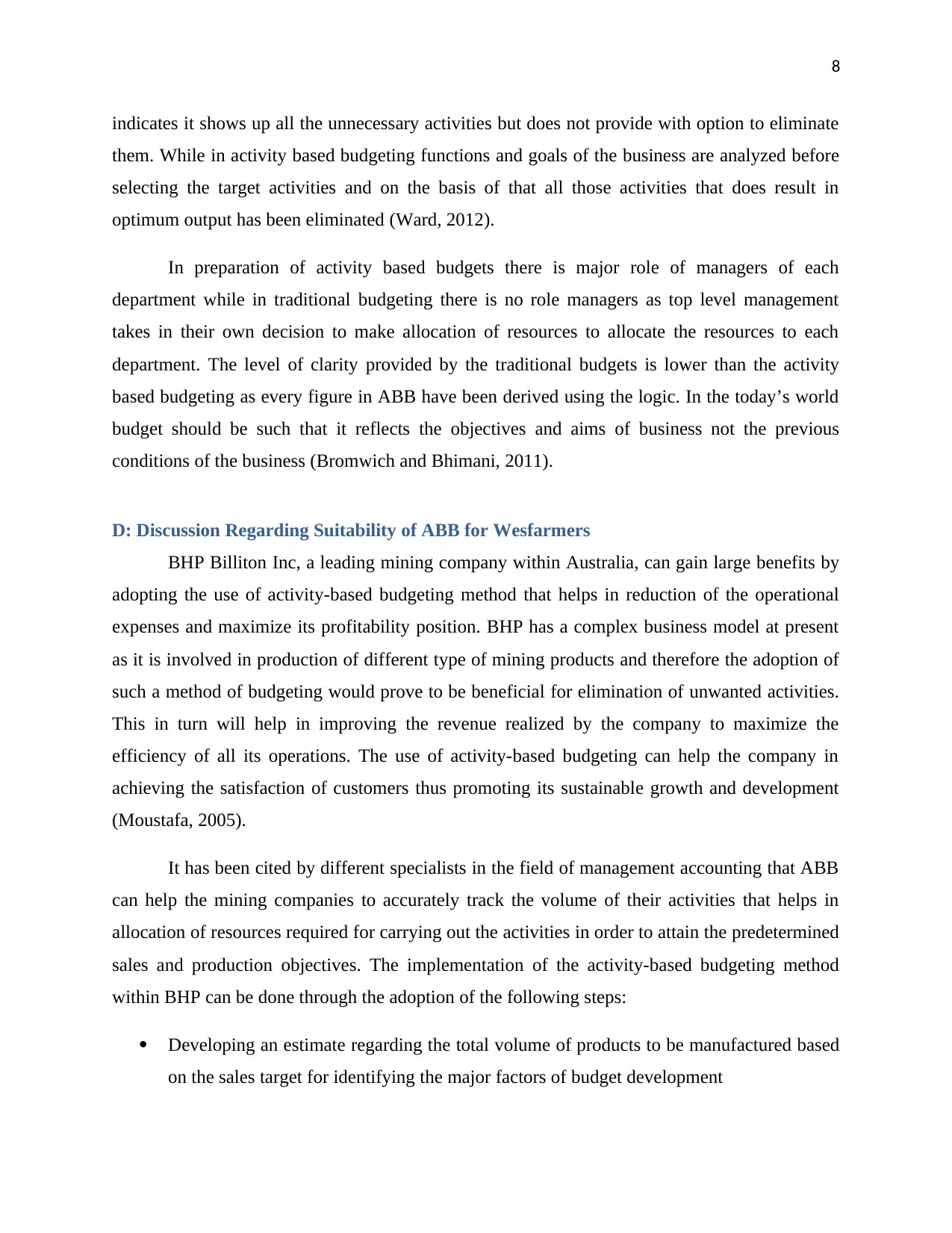
8
indicates it shows up all the unnecessary activities but does not provide with option to eliminate
them. While in activity based budgeting functions and goals of the business are analyzed before
selecting the target activities and on the basis of that all those activities that does result in
optimum output has been eliminated (Ward, 2012).
In preparation of activity based budgets there is major role of managers of each
department while in traditional budgeting there is no role managers as top level management
takes in their own decision to make allocation of resources to allocate the resources to each
department. The level of clarity provided by the traditional budgets is lower than the activity
based budgeting as every figure in ABB have been derived using the logic. In the today’s world
budget should be such that it reflects the objectives and aims of business not the previous
conditions of the business (Bromwich and Bhimani, 2011).
D: Discussion Regarding Suitability of ABB for Wesfarmers
BHP Billiton Inc, a leading mining company within Australia, can gain large benefits by
adopting the use of activity-based budgeting method that helps in reduction of the operational
expenses and maximize its profitability position. BHP has a complex business model at present
as it is involved in production of different type of mining products and therefore the adoption of
such a method of budgeting would prove to be beneficial for elimination of unwanted activities.
This in turn will help in improving the revenue realized by the company to maximize the
efficiency of all its operations. The use of activity-based budgeting can help the company in
achieving the satisfaction of customers thus promoting its sustainable growth and development
(Moustafa, 2005).
It has been cited by different specialists in the field of management accounting that ABB
can help the mining companies to accurately track the volume of their activities that helps in
allocation of resources required for carrying out the activities in order to attain the predetermined
sales and production objectives. The implementation of the activity-based budgeting method
within BHP can be done through the adoption of the following steps:
Developing an estimate regarding the total volume of products to be manufactured based
on the sales target for identifying the major factors of budget development
indicates it shows up all the unnecessary activities but does not provide with option to eliminate
them. While in activity based budgeting functions and goals of the business are analyzed before
selecting the target activities and on the basis of that all those activities that does result in
optimum output has been eliminated (Ward, 2012).
In preparation of activity based budgets there is major role of managers of each
department while in traditional budgeting there is no role managers as top level management
takes in their own decision to make allocation of resources to allocate the resources to each
department. The level of clarity provided by the traditional budgets is lower than the activity
based budgeting as every figure in ABB have been derived using the logic. In the today’s world
budget should be such that it reflects the objectives and aims of business not the previous
conditions of the business (Bromwich and Bhimani, 2011).
D: Discussion Regarding Suitability of ABB for Wesfarmers
BHP Billiton Inc, a leading mining company within Australia, can gain large benefits by
adopting the use of activity-based budgeting method that helps in reduction of the operational
expenses and maximize its profitability position. BHP has a complex business model at present
as it is involved in production of different type of mining products and therefore the adoption of
such a method of budgeting would prove to be beneficial for elimination of unwanted activities.
This in turn will help in improving the revenue realized by the company to maximize the
efficiency of all its operations. The use of activity-based budgeting can help the company in
achieving the satisfaction of customers thus promoting its sustainable growth and development
(Moustafa, 2005).
It has been cited by different specialists in the field of management accounting that ABB
can help the mining companies to accurately track the volume of their activities that helps in
allocation of resources required for carrying out the activities in order to attain the predetermined
sales and production objectives. The implementation of the activity-based budgeting method
within BHP can be done through the adoption of the following steps:
Developing an estimate regarding the total volume of products to be manufactured based
on the sales target for identifying the major factors of budget development
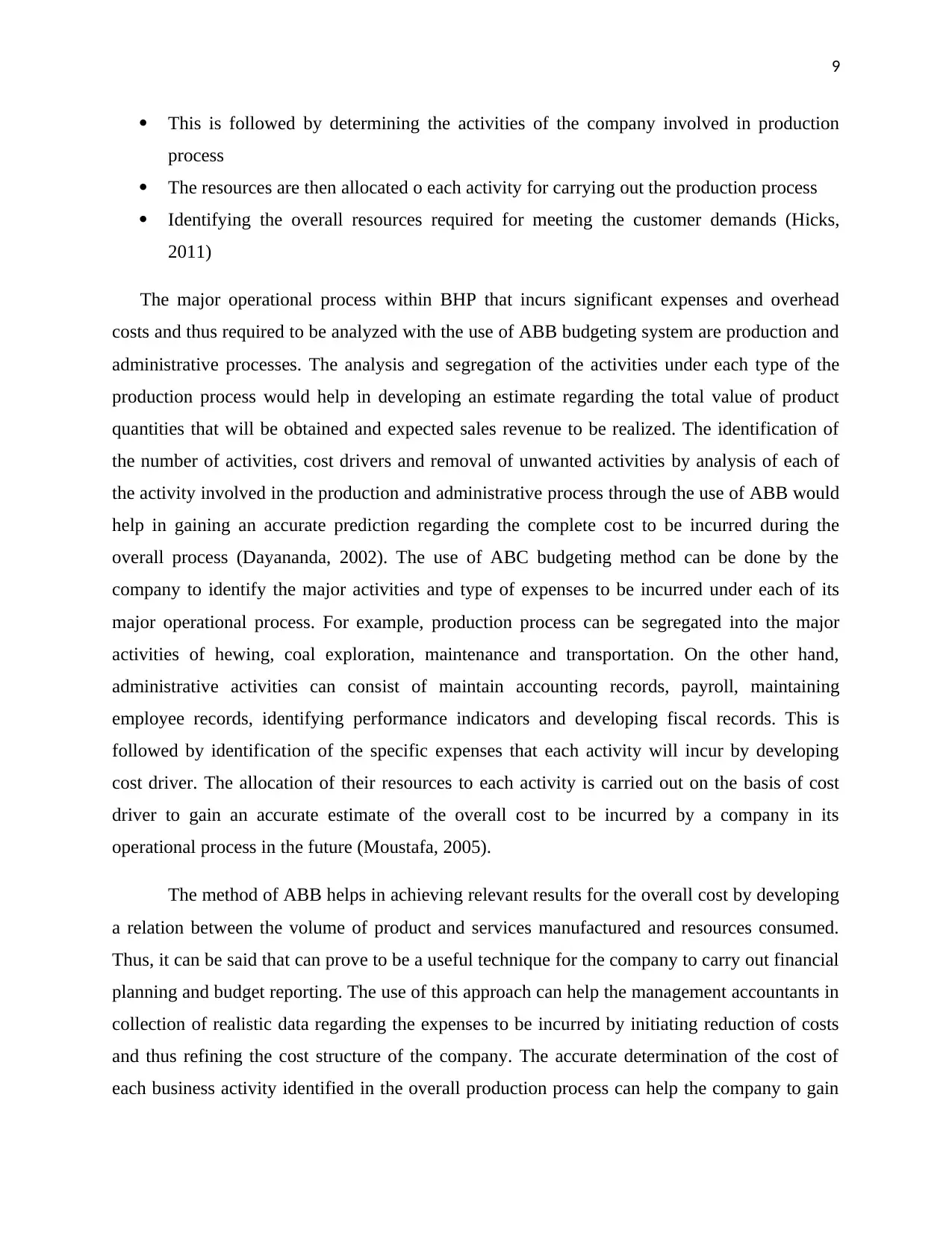
9
This is followed by determining the activities of the company involved in production
process
The resources are then allocated o each activity for carrying out the production process
Identifying the overall resources required for meeting the customer demands (Hicks,
2011)
The major operational process within BHP that incurs significant expenses and overhead
costs and thus required to be analyzed with the use of ABB budgeting system are production and
administrative processes. The analysis and segregation of the activities under each type of the
production process would help in developing an estimate regarding the total value of product
quantities that will be obtained and expected sales revenue to be realized. The identification of
the number of activities, cost drivers and removal of unwanted activities by analysis of each of
the activity involved in the production and administrative process through the use of ABB would
help in gaining an accurate prediction regarding the complete cost to be incurred during the
overall process (Dayananda, 2002). The use of ABC budgeting method can be done by the
company to identify the major activities and type of expenses to be incurred under each of its
major operational process. For example, production process can be segregated into the major
activities of hewing, coal exploration, maintenance and transportation. On the other hand,
administrative activities can consist of maintain accounting records, payroll, maintaining
employee records, identifying performance indicators and developing fiscal records. This is
followed by identification of the specific expenses that each activity will incur by developing
cost driver. The allocation of their resources to each activity is carried out on the basis of cost
driver to gain an accurate estimate of the overall cost to be incurred by a company in its
operational process in the future (Moustafa, 2005).
The method of ABB helps in achieving relevant results for the overall cost by developing
a relation between the volume of product and services manufactured and resources consumed.
Thus, it can be said that can prove to be a useful technique for the company to carry out financial
planning and budget reporting. The use of this approach can help the management accountants in
collection of realistic data regarding the expenses to be incurred by initiating reduction of costs
and thus refining the cost structure of the company. The accurate determination of the cost of
each business activity identified in the overall production process can help the company to gain
This is followed by determining the activities of the company involved in production
process
The resources are then allocated o each activity for carrying out the production process
Identifying the overall resources required for meeting the customer demands (Hicks,
2011)
The major operational process within BHP that incurs significant expenses and overhead
costs and thus required to be analyzed with the use of ABB budgeting system are production and
administrative processes. The analysis and segregation of the activities under each type of the
production process would help in developing an estimate regarding the total value of product
quantities that will be obtained and expected sales revenue to be realized. The identification of
the number of activities, cost drivers and removal of unwanted activities by analysis of each of
the activity involved in the production and administrative process through the use of ABB would
help in gaining an accurate prediction regarding the complete cost to be incurred during the
overall process (Dayananda, 2002). The use of ABC budgeting method can be done by the
company to identify the major activities and type of expenses to be incurred under each of its
major operational process. For example, production process can be segregated into the major
activities of hewing, coal exploration, maintenance and transportation. On the other hand,
administrative activities can consist of maintain accounting records, payroll, maintaining
employee records, identifying performance indicators and developing fiscal records. This is
followed by identification of the specific expenses that each activity will incur by developing
cost driver. The allocation of their resources to each activity is carried out on the basis of cost
driver to gain an accurate estimate of the overall cost to be incurred by a company in its
operational process in the future (Moustafa, 2005).
The method of ABB helps in achieving relevant results for the overall cost by developing
a relation between the volume of product and services manufactured and resources consumed.
Thus, it can be said that can prove to be a useful technique for the company to carry out financial
planning and budget reporting. The use of this approach can help the management accountants in
collection of realistic data regarding the expenses to be incurred by initiating reduction of costs
and thus refining the cost structure of the company. The accurate determination of the cost of
each business activity identified in the overall production process can help the company to gain
⊘ This is a preview!⊘
Do you want full access?
Subscribe today to unlock all pages.

Trusted by 1+ million students worldwide
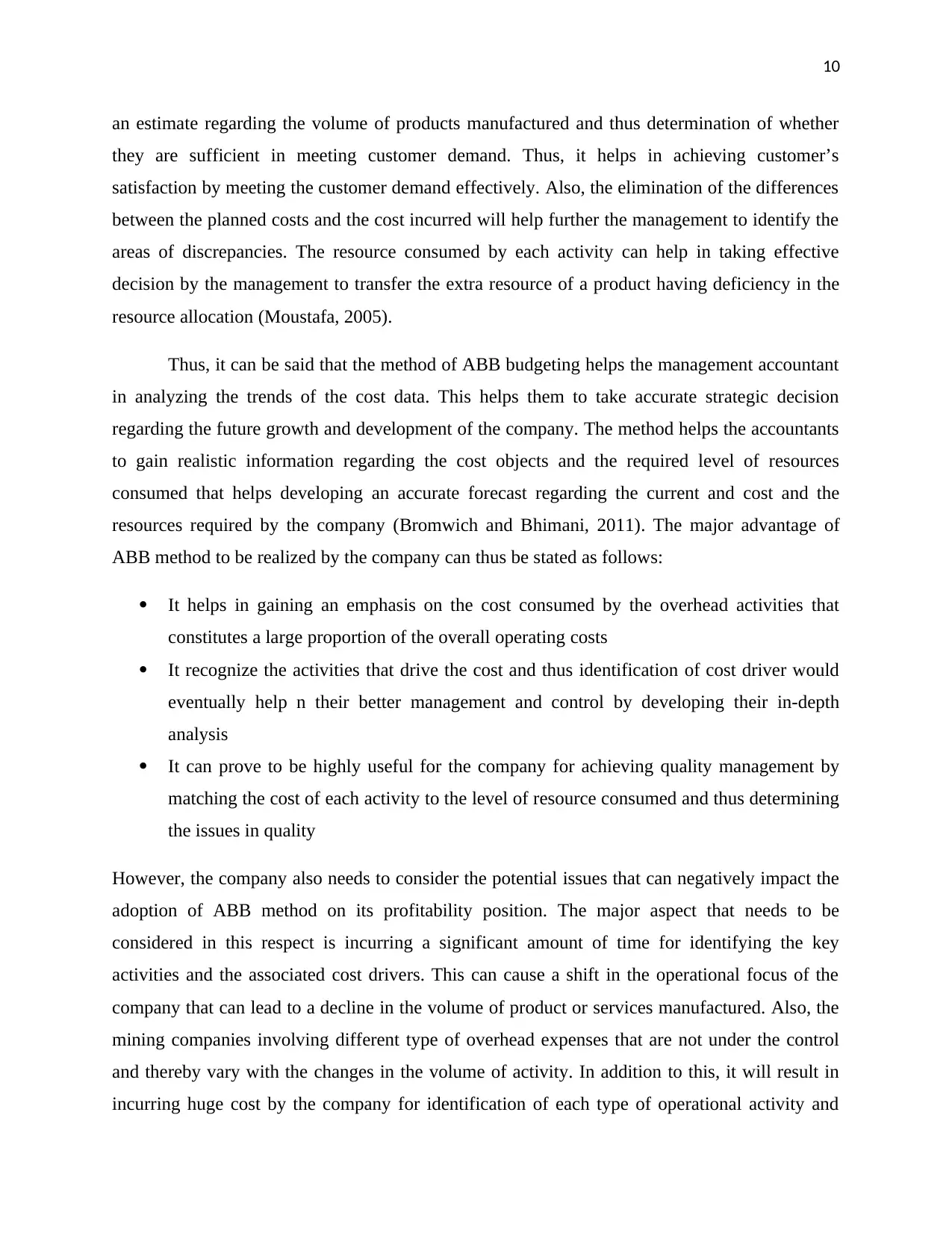
10
an estimate regarding the volume of products manufactured and thus determination of whether
they are sufficient in meeting customer demand. Thus, it helps in achieving customer’s
satisfaction by meeting the customer demand effectively. Also, the elimination of the differences
between the planned costs and the cost incurred will help further the management to identify the
areas of discrepancies. The resource consumed by each activity can help in taking effective
decision by the management to transfer the extra resource of a product having deficiency in the
resource allocation (Moustafa, 2005).
Thus, it can be said that the method of ABB budgeting helps the management accountant
in analyzing the trends of the cost data. This helps them to take accurate strategic decision
regarding the future growth and development of the company. The method helps the accountants
to gain realistic information regarding the cost objects and the required level of resources
consumed that helps developing an accurate forecast regarding the current and cost and the
resources required by the company (Bromwich and Bhimani, 2011). The major advantage of
ABB method to be realized by the company can thus be stated as follows:
It helps in gaining an emphasis on the cost consumed by the overhead activities that
constitutes a large proportion of the overall operating costs
It recognize the activities that drive the cost and thus identification of cost driver would
eventually help n their better management and control by developing their in-depth
analysis
It can prove to be highly useful for the company for achieving quality management by
matching the cost of each activity to the level of resource consumed and thus determining
the issues in quality
However, the company also needs to consider the potential issues that can negatively impact the
adoption of ABB method on its profitability position. The major aspect that needs to be
considered in this respect is incurring a significant amount of time for identifying the key
activities and the associated cost drivers. This can cause a shift in the operational focus of the
company that can lead to a decline in the volume of product or services manufactured. Also, the
mining companies involving different type of overhead expenses that are not under the control
and thereby vary with the changes in the volume of activity. In addition to this, it will result in
incurring huge cost by the company for identification of each type of operational activity and
an estimate regarding the volume of products manufactured and thus determination of whether
they are sufficient in meeting customer demand. Thus, it helps in achieving customer’s
satisfaction by meeting the customer demand effectively. Also, the elimination of the differences
between the planned costs and the cost incurred will help further the management to identify the
areas of discrepancies. The resource consumed by each activity can help in taking effective
decision by the management to transfer the extra resource of a product having deficiency in the
resource allocation (Moustafa, 2005).
Thus, it can be said that the method of ABB budgeting helps the management accountant
in analyzing the trends of the cost data. This helps them to take accurate strategic decision
regarding the future growth and development of the company. The method helps the accountants
to gain realistic information regarding the cost objects and the required level of resources
consumed that helps developing an accurate forecast regarding the current and cost and the
resources required by the company (Bromwich and Bhimani, 2011). The major advantage of
ABB method to be realized by the company can thus be stated as follows:
It helps in gaining an emphasis on the cost consumed by the overhead activities that
constitutes a large proportion of the overall operating costs
It recognize the activities that drive the cost and thus identification of cost driver would
eventually help n their better management and control by developing their in-depth
analysis
It can prove to be highly useful for the company for achieving quality management by
matching the cost of each activity to the level of resource consumed and thus determining
the issues in quality
However, the company also needs to consider the potential issues that can negatively impact the
adoption of ABB method on its profitability position. The major aspect that needs to be
considered in this respect is incurring a significant amount of time for identifying the key
activities and the associated cost drivers. This can cause a shift in the operational focus of the
company that can lead to a decline in the volume of product or services manufactured. Also, the
mining companies involving different type of overhead expenses that are not under the control
and thereby vary with the changes in the volume of activity. In addition to this, it will result in
incurring huge cost by the company for identification of each type of operational activity and
Paraphrase This Document
Need a fresh take? Get an instant paraphrase of this document with our AI Paraphraser
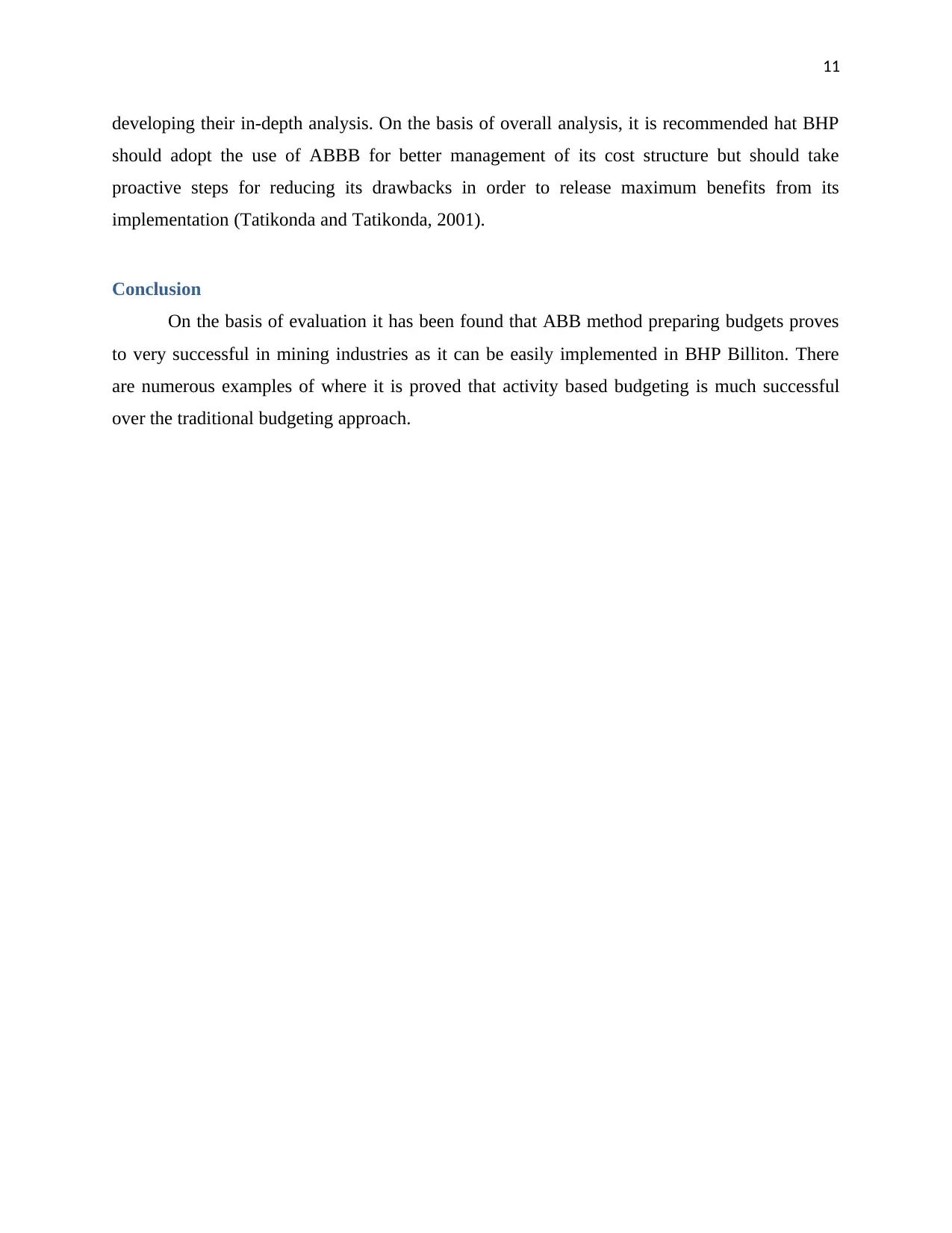
11
developing their in-depth analysis. On the basis of overall analysis, it is recommended hat BHP
should adopt the use of ABBB for better management of its cost structure but should take
proactive steps for reducing its drawbacks in order to release maximum benefits from its
implementation (Tatikonda and Tatikonda, 2001).
Conclusion
On the basis of evaluation it has been found that ABB method preparing budgets proves
to very successful in mining industries as it can be easily implemented in BHP Billiton. There
are numerous examples of where it is proved that activity based budgeting is much successful
over the traditional budgeting approach.
developing their in-depth analysis. On the basis of overall analysis, it is recommended hat BHP
should adopt the use of ABBB for better management of its cost structure but should take
proactive steps for reducing its drawbacks in order to release maximum benefits from its
implementation (Tatikonda and Tatikonda, 2001).
Conclusion
On the basis of evaluation it has been found that ABB method preparing budgets proves
to very successful in mining industries as it can be easily implemented in BHP Billiton. There
are numerous examples of where it is proved that activity based budgeting is much successful
over the traditional budgeting approach.
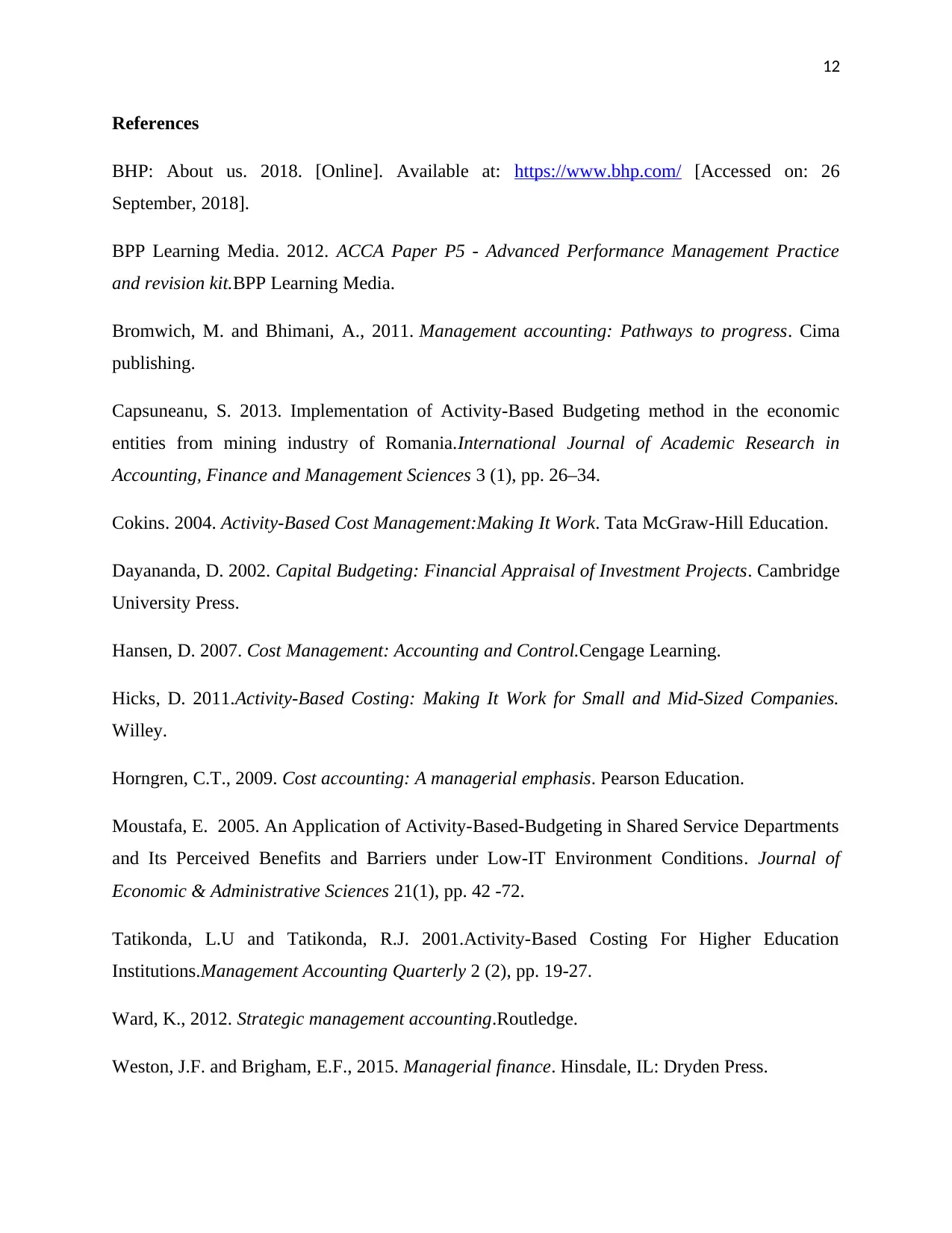
12
References
BHP: About us. 2018. [Online]. Available at: https://www.bhp.com/ [Accessed on: 26
September, 2018].
BPP Learning Media. 2012. ACCA Paper P5 - Advanced Performance Management Practice
and revision kit.BPP Learning Media.
Bromwich, M. and Bhimani, A., 2011. Management accounting: Pathways to progress. Cima
publishing.
Capsuneanu, S. 2013. Implementation of Activity-Based Budgeting method in the economic
entities from mining industry of Romania.International Journal of Academic Research in
Accounting, Finance and Management Sciences 3 (1), pp. 26–34.
Cokins. 2004. Activity-Based Cost Management:Making It Work. Tata McGraw-Hill Education.
Dayananda, D. 2002. Capital Budgeting: Financial Appraisal of Investment Projects. Cambridge
University Press.
Hansen, D. 2007. Cost Management: Accounting and Control.Cengage Learning.
Hicks, D. 2011.Activity-Based Costing: Making It Work for Small and Mid-Sized Companies.
Willey.
Horngren, C.T., 2009. Cost accounting: A managerial emphasis. Pearson Education.
Moustafa, E. 2005. An Application of Activity-Based-Budgeting in Shared Service Departments
and Its Perceived Benefits and Barriers under Low-IT Environment Conditions. Journal of
Economic & Administrative Sciences 21(1), pp. 42 -72.
Tatikonda, L.U and Tatikonda, R.J. 2001.Activity-Based Costing For Higher Education
Institutions.Management Accounting Quarterly 2 (2), pp. 19-27.
Ward, K., 2012. Strategic management accounting.Routledge.
Weston, J.F. and Brigham, E.F., 2015. Managerial finance. Hinsdale, IL: Dryden Press.
References
BHP: About us. 2018. [Online]. Available at: https://www.bhp.com/ [Accessed on: 26
September, 2018].
BPP Learning Media. 2012. ACCA Paper P5 - Advanced Performance Management Practice
and revision kit.BPP Learning Media.
Bromwich, M. and Bhimani, A., 2011. Management accounting: Pathways to progress. Cima
publishing.
Capsuneanu, S. 2013. Implementation of Activity-Based Budgeting method in the economic
entities from mining industry of Romania.International Journal of Academic Research in
Accounting, Finance and Management Sciences 3 (1), pp. 26–34.
Cokins. 2004. Activity-Based Cost Management:Making It Work. Tata McGraw-Hill Education.
Dayananda, D. 2002. Capital Budgeting: Financial Appraisal of Investment Projects. Cambridge
University Press.
Hansen, D. 2007. Cost Management: Accounting and Control.Cengage Learning.
Hicks, D. 2011.Activity-Based Costing: Making It Work for Small and Mid-Sized Companies.
Willey.
Horngren, C.T., 2009. Cost accounting: A managerial emphasis. Pearson Education.
Moustafa, E. 2005. An Application of Activity-Based-Budgeting in Shared Service Departments
and Its Perceived Benefits and Barriers under Low-IT Environment Conditions. Journal of
Economic & Administrative Sciences 21(1), pp. 42 -72.
Tatikonda, L.U and Tatikonda, R.J. 2001.Activity-Based Costing For Higher Education
Institutions.Management Accounting Quarterly 2 (2), pp. 19-27.
Ward, K., 2012. Strategic management accounting.Routledge.
Weston, J.F. and Brigham, E.F., 2015. Managerial finance. Hinsdale, IL: Dryden Press.
⊘ This is a preview!⊘
Do you want full access?
Subscribe today to unlock all pages.

Trusted by 1+ million students worldwide
1 out of 12
Related Documents
Your All-in-One AI-Powered Toolkit for Academic Success.
+13062052269
info@desklib.com
Available 24*7 on WhatsApp / Email
![[object Object]](/_next/static/media/star-bottom.7253800d.svg)
Unlock your academic potential
Copyright © 2020–2025 A2Z Services. All Rights Reserved. Developed and managed by ZUCOL.




